December 24, 1999
ART REVIEW
Adrian Piper: A Canvas of Concerns -- Race, Racism and Class
Forum
Join a Discussion on Artists and Exhibitions
By HOLLAND COTTER
 ALTIMORE -- For art, the
1990's started in a mood of agitation.
The market went down the drain.
AIDS was rampant. The 1993 Whitney Biennial, the most important
American contemporary showcase
of the decade, was a full-voiced
chorus of long-excluded voices,
black, Latino, gay and feminist
among them.
ALTIMORE -- For art, the
1990's started in a mood of agitation.
The market went down the drain.
AIDS was rampant. The 1993 Whitney Biennial, the most important
American contemporary showcase
of the decade, was a full-voiced
chorus of long-excluded voices,
black, Latino, gay and feminist
among them.
|

University of Maryland Fine Arts Gallery
|
Adrian Piper's "My Calling (Card) No.2"(1986-90)
|
What a difference a few years
make. The 90's are ending on a complacent, upbeat note. Economics are
back on track. AIDS has become the
scourge of the silent poor at home
and abroad. The art world has joined
the rest of the world in dismissing
politically concerned art as "politically correct."
All of this provides an interesting
context for the traveling midcareer
retrospective of work by the American artist Adrian Piper, making its
inaugural appearance at the Fine
Arts Gallery of the University of
Maryland, Baltimore County, a half-hour drive from the center of Baltimore.
Her work is about consciousness-raising. Her primary subjects are
race, racism and their links to class
and gender. Her forms are spare,
unsensual, but for the most part attention-holding. Her method is interrogatory: she asks unsettling questions to evoke revealing responses.
Sugar-coating isn't her style.
The retrospective, organized by
the art historian Maurice Berger and
accompanied by a solid catalog, covers roughly 30 years. A few crucial
pieces are missing, notably the photo-and-text-based drawings of the
1970's known as the "Mythic Being"
series. (They will join the show at a
later venue.) But the show is still as
complete a view of this influential
artist's career as we have had.
It begins with paintings from 1966,
when Ms. Piper was barely out of
high school. One, titled "LSD Self-Portrait From the Inside Out," is
period-piece psychedelia: an image
of a black woman surrounded by an
aura of high-color, splitting-apart
geometric shards. The other, "Multichrome Mom and Dad," is a snapshotlike portrait of her parents, done
in shades of gray except for the
faces, which are biscuit-brown.

University of Maryland Fine Arts Gallery
|
Adrian Piper's "Self-Portrait Exaggerating My Negroid Features" (1981)
|
|
Although little more than juvenilia, the pictures point up essential
aspects of Ms. Piper's work as a
whole. The human figure and abstract forms play interactive roles.
Autobiographical data recurs but is
kept impersonal, always about something else, ideas as well as emotions.
For example, the artist uses the fact
that both her parents were of mixed-race heritage as a strategic point
from which to attack essentialist
concepts of race itself.
In the late 1960's Ms. Piper aligned
herself with the nascent Conceptual
art movement, attracted to its intellectual rigor and speculative logic.
At the same time, her political convictions were growing acute and specific. She brought these strands together (she was among the first artists to do so) in performance pieces
executed in private and in public.
"Food for the Spirit" (1970) was
among her early private solo pieces,
done when she was finishing a degree in philosophy at City College in
New York. She approached an intensive study of Emmanuel Kant as a
kind of yogic discipline, fasting as
she worked. She recorded her appearance during this hermetic period in a series of remarkable photographs in which her body seems to be
gradually dematerializing.
Her public performances, by contrast, were often assertive and disruptive. For the "Mythic Being" series, she disguised herself as a black
or Latino teenager in an Afro wig
and acted out stereotypes of antisocial behavior, cruising women in the
street, even staging a fake mugging.
A single piece in the show catches
the spirit: it is a head shot of the
bewigged artist with a thought balloon that reads, "I embody everything you most hate and fear."
Ms. Piper repeatedly appears in
her own work, assuming different
personae (she's a skilled and witty
performer) and changing her looks
as if she were herself a kind of malleable conceptual object.
Sometimes she is just a voice, as in
the installation titled "Art for Art
World Surface Pattern" (1976). The
piece consists of a walk-in white cubicle resembling an abstract sculpture. The interior is papered with
photos of calamitous third world
events for which Ms. Piper supplies
an exasperated-sounding taped commentary that begins: "Oh, I get it.
O.K. Got it. This is social conscience
art. Right. O.K. You know, I mean, I
don't need this when I come to an art
show."
Most of her role-playing, however,
is visual. In a 1981 pencil drawing
titled "Self-Portrait Exaggerating
My Negroid Features" she gives a
cosmetic makeover the grim and
haunted look of a mug shot. Elsewhere she plays with the educational
aspects of her career as both didactic artist and professional academic.
(She teaches philosophy at Wellesley
College in Massachusetts.)
In a terrific, funny video titled
"Funk Lessons" (1983), she earnestly uses diagrams and personal demonstrations to instruct students in the
how-to's of popular music and dance,
generating lively class participation
in the process. In "Cornered" (1988),
she is filmed sitting behind a desk
and explaining with unflappable,
schoolmarmish composure that
most Americans are, like her, genetically black, even if their physical
appearance seems to say otherwise.
This information also forms the
basis for performance pieces she executed in social situations in the late
1980's. Their occurrence was spontaneous, their format simple: when she
overheard casually dropped ethnic
slurs at parties or dinners, she offered the offending speaker a business card printed with the words:
"Dear Friend. I am black. I am sure
you did not realize this when you
made/laughed at/agreed with that
racist remark."
Ms. Piper has placed a supply of
these cards in the Baltimore show
under the words: "Join the struggle.
Take some for your own use." The
implication is that any viewers,
whatever their preferred racial self-identity, are eligible to pass them
out. And that assumption gets to the
radical core of what Ms. Piper's
work is about.
On the most obvious level, her mission is to reveal racist attitudes and
behavior, overt or hidden, and call
them by their right name. But she
also provocatively suggests that
such attitudes and behavior actually
create race as a perceptual category
and that that category, however illusory, reinforces hierarchies of socioeconomic power and exclusion.
The idea of race as a construct, one
producing tightly scripted and limiting roles, is being closely examined
these days, with important implications for art.
Although increasing numbers of
young artists of African-American
descent are forging careers, their
number is still small and most are
faced with "ethnic" expectations in
terms of subject matter (colonialism, spirituality) and materials (elephant dung, for example), as were
artists before them, including a
whole generation of abstract painters.
But the issue of ethnicity and post-ethnicity, intrinsic to the multiculturalist thinking of the 1990's, is far
from being resolved and may stay
that way. Racism, meanwhile, remains a fact. The black middle class
is growing, but so is the black prison
population. American consumerism
is more and more an equal opportunity affair, but the hard-won benefits
and protections gained by blacks
during the civil rights era are now
being legally dismantled.
And so Ms. Piper's role as agent
provocateur is as valid as ever. Her
persistence in exposing the mechanics of prejudice, her insistence on the
double-edged dangers inherent in the
perception of difference, and her passionately instrumental view of art as
a mind-altering and expanding substance make her just as much an
artist of the moment today -- a stimulating and prophetic one -- as she
has been for the last 30 years.